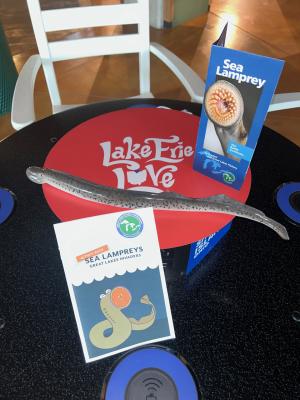If a marine animal was described as a vampire fish, with a suction cup mouth full of razor-sharp teeth, one might think it is an April fools’ joke or a character in a low budget sci-fi movie. However, this is a real fish that can be found in the Great Lakes. Move over zebra mussels! It’s time to learn about an eel-like fish known as a sea lamprey.
 The sea lamprey is one of the aquatic invasive species listed as a threat by the Ohio Department of Natural Resources (ODNR). Invasive species are non-native organisms that are degrading the habitat or ecosystem that they occupy. This can include plants, animals, insects, or fungi. One characteristic of these types of species is that they can populate and disseminate easily.
The sea lamprey is one of the aquatic invasive species listed as a threat by the Ohio Department of Natural Resources (ODNR). Invasive species are non-native organisms that are degrading the habitat or ecosystem that they occupy. This can include plants, animals, insects, or fungi. One characteristic of these types of species is that they can populate and disseminate easily.
Though it has eel-like qualities, the lamprey is not closely related. The lamprey has no jaw and uses its circular mouth to attach onto other fish. More than 100 teeth surround a file like tongue and aid the lamprey in puncturing of skin of the other fish to drain its bodily fluids for sustenance. An adult lamprey can be as long as two and a half feet. Imagine the surprise of reeling in a walleye and an alien-looking rider! Fortunately, human bites are quite rare.
There are seven total species of lamprey, with six of them considered native to Ohio waterways. The sea lamprey is the non-native rabble rouser, acting as a nuisance to the fish population and economy in the Great Lakes since the 1920s. As Lake Erie is the shallowest and warmest great lake, it allowed for lamprey to easily multiply once they made their way to the lake from the Atlantic Ocean. To give an idea of impact, one single lamprey can destroy up to 18 lbs. of fish in one year. The worst fallout from the species was roughly 1940-1950. To illustrate this, in 1940 over 2,700,000 lbs. of lake trout were fished in a one-year bracket. By 1946 the pounds of fish plummeted to just 760,000 in an identical time frame.
 Populations are on the rise again in recent years and scientists have worked to find solutions to limit the species without causing damage to the lakes. One way to combat the populace is to use small amounts of a compound that are fatal to lamprey larvae. The compound is 3-trifluoromethyl-4-nitrophenol (known as TFM). This is used cautiously and only in interval stages in tributaries to the Great Lakes. Simple traps and barriers can also be installed to slow or restrict movement. The most recent technique is based off the fact lampreys have a sharp sense of smell. Pheromones, which are natural odors organisms emit, can be used to bait the lamprey to areas where traps are deployed.
Populations are on the rise again in recent years and scientists have worked to find solutions to limit the species without causing damage to the lakes. One way to combat the populace is to use small amounts of a compound that are fatal to lamprey larvae. The compound is 3-trifluoromethyl-4-nitrophenol (known as TFM). This is used cautiously and only in interval stages in tributaries to the Great Lakes. Simple traps and barriers can also be installed to slow or restrict movement. The most recent technique is based off the fact lampreys have a sharp sense of smell. Pheromones, which are natural odors organisms emit, can be used to bait the lamprey to areas where traps are deployed.
Currently the total count of lamprey can be considered a roughly 90% reduction compared to past years; yet it is still an uphill battle to protect the fishery of the Great Lakes. And oddly enough for their not so charming appearance, lampreys were considered delicacy in Medieval England. They were given as gifts to royalty, even presented in pies, as a means of seeking favor.
Overall, education is the way to help protect our ecosystem from invasive species! The list for Ohio can be found on the ODNR website (www.ohiodnr.gov). Be sure to check out a current documentary “The Fish Thief” which is streaming on several platforms for a deeper information dive. Informative pamphlets on lamprey can be picked up, along with a kids’ activity book, at either of the Shores & Islands Ohio welcome centers. While you browse our Port Clinton welcome center, see if you can spy our lamprey figurine (when you spot him, come to the front desk and say “lamprey pie” for a fun prize!). He is the kind we like though, harmless!
Learn more about Shores & Islands Ohio fish and fishing opportunities on our Fishing page.



